Marketing Essentials: Analysis of IKEA's Marketing Strategy Report
VerifiedAdded on 2020/10/23
|15
|3367
|193
Report
AI Summary
This report provides a comprehensive analysis of IKEA's marketing essentials. It begins with an introduction to marketing principles and then delves into the key roles and responsibilities within a marketing function, relating them to the broader organizational context. The report then focuses on IKEA, examining its use of the 7Ps of the marketing mix (Product, Price, Promotion, Place, People, Process, and Physical evidence) to achieve its business objectives. Furthermore, the report evaluates a basic marketing plan for IKEA, including its objectives, SWOT analysis (Strengths, Weaknesses, Opportunities, and Threats), and PESTLE analysis (Political, Economic, Social, Technological, Legal, and Environmental factors). The analysis provides insights into IKEA's strategic approach, market positioning, and the factors influencing its success in the global market. The report concludes with a summary of the key findings and references used.

MARKETING ESSENTIALS
Paraphrase This Document
Need a fresh take? Get an instant paraphrase of this document with our AI Paraphraser
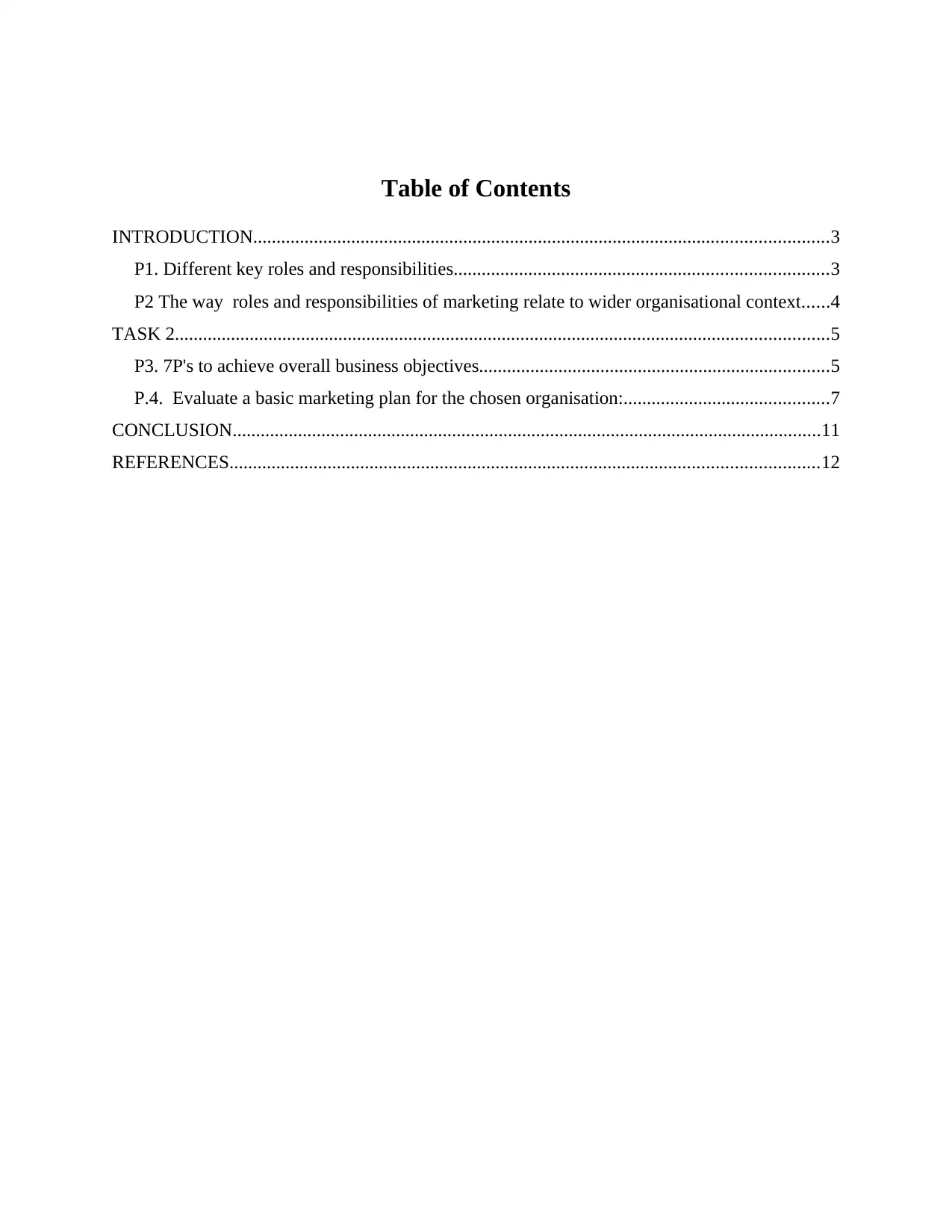
Table of Contents
INTRODUCTION...........................................................................................................................3
P1. Different key roles and responsibilities................................................................................3
P2 The way roles and responsibilities of marketing relate to wider organisational context......4
TASK 2............................................................................................................................................5
P3. 7P's to achieve overall business objectives...........................................................................5
P.4. Evaluate a basic marketing plan for the chosen organisation:............................................7
CONCLUSION..............................................................................................................................11
REFERENCES..............................................................................................................................12
INTRODUCTION...........................................................................................................................3
P1. Different key roles and responsibilities................................................................................3
P2 The way roles and responsibilities of marketing relate to wider organisational context......4
TASK 2............................................................................................................................................5
P3. 7P's to achieve overall business objectives...........................................................................5
P.4. Evaluate a basic marketing plan for the chosen organisation:............................................7
CONCLUSION..............................................................................................................................11
REFERENCES..............................................................................................................................12
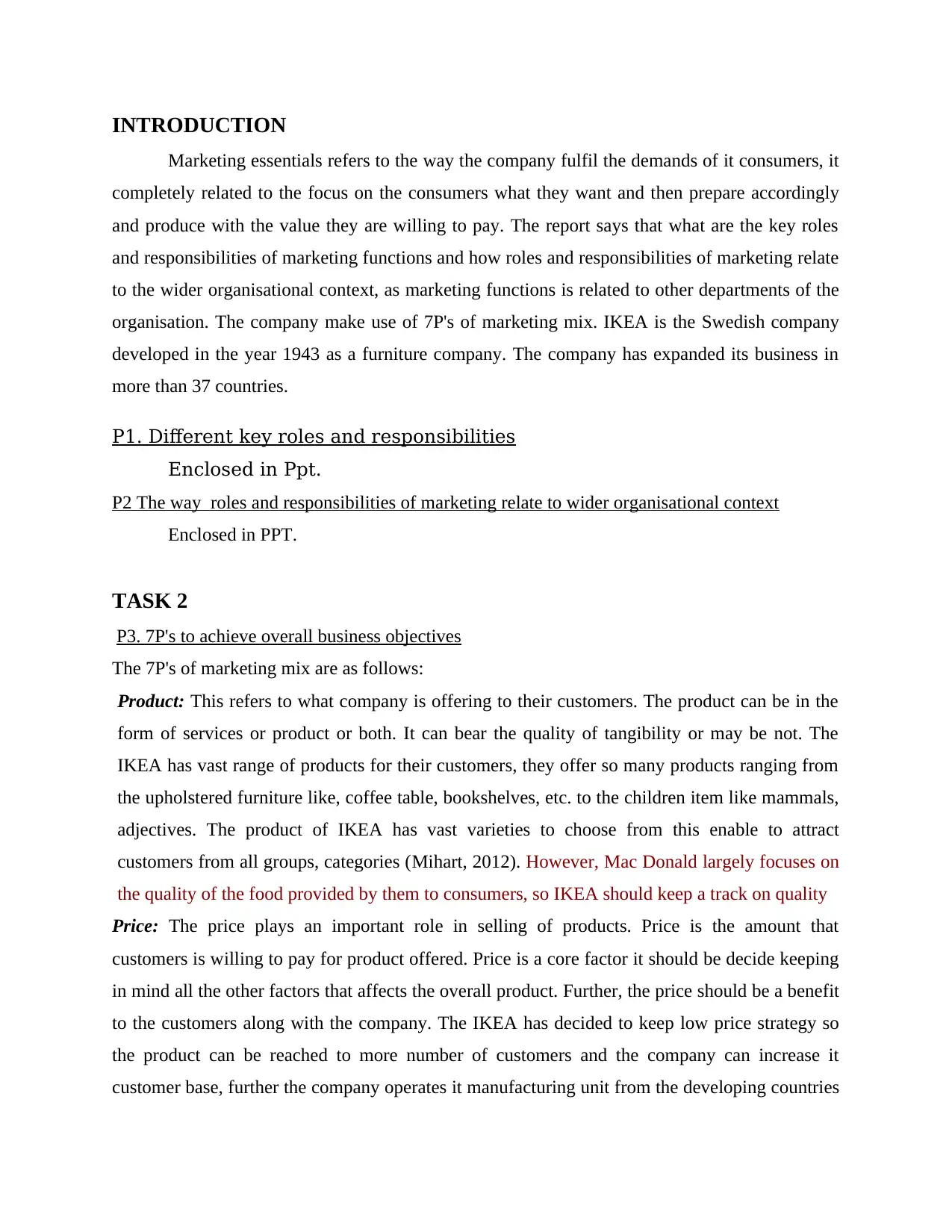
INTRODUCTION
Marketing essentials refers to the way the company fulfil the demands of it consumers, it
completely related to the focus on the consumers what they want and then prepare accordingly
and produce with the value they are willing to pay. The report says that what are the key roles
and responsibilities of marketing functions and how roles and responsibilities of marketing relate
to the wider organisational context, as marketing functions is related to other departments of the
organisation. The company make use of 7P's of marketing mix. IKEA is the Swedish company
developed in the year 1943 as a furniture company. The company has expanded its business in
more than 37 countries.
P1. Different key roles and responsibilities
Enclosed in Ppt.
P2 The way roles and responsibilities of marketing relate to wider organisational context
Enclosed in PPT.
TASK 2
P3. 7P's to achieve overall business objectives
The 7P's of marketing mix are as follows:
Product: This refers to what company is offering to their customers. The product can be in the
form of services or product or both. It can bear the quality of tangibility or may be not. The
IKEA has vast range of products for their customers, they offer so many products ranging from
the upholstered furniture like, coffee table, bookshelves, etc. to the children item like mammals,
adjectives. The product of IKEA has vast varieties to choose from this enable to attract
customers from all groups, categories (Mihart, 2012). However, Mac Donald largely focuses on
the quality of the food provided by them to consumers, so IKEA should keep a track on quality
Price: The price plays an important role in selling of products. Price is the amount that
customers is willing to pay for product offered. Price is a core factor it should be decide keeping
in mind all the other factors that affects the overall product. Further, the price should be a benefit
to the customers along with the company. The IKEA has decided to keep low price strategy so
the product can be reached to more number of customers and the company can increase it
customer base, further the company operates it manufacturing unit from the developing countries
Marketing essentials refers to the way the company fulfil the demands of it consumers, it
completely related to the focus on the consumers what they want and then prepare accordingly
and produce with the value they are willing to pay. The report says that what are the key roles
and responsibilities of marketing functions and how roles and responsibilities of marketing relate
to the wider organisational context, as marketing functions is related to other departments of the
organisation. The company make use of 7P's of marketing mix. IKEA is the Swedish company
developed in the year 1943 as a furniture company. The company has expanded its business in
more than 37 countries.
P1. Different key roles and responsibilities
Enclosed in Ppt.
P2 The way roles and responsibilities of marketing relate to wider organisational context
Enclosed in PPT.
TASK 2
P3. 7P's to achieve overall business objectives
The 7P's of marketing mix are as follows:
Product: This refers to what company is offering to their customers. The product can be in the
form of services or product or both. It can bear the quality of tangibility or may be not. The
IKEA has vast range of products for their customers, they offer so many products ranging from
the upholstered furniture like, coffee table, bookshelves, etc. to the children item like mammals,
adjectives. The product of IKEA has vast varieties to choose from this enable to attract
customers from all groups, categories (Mihart, 2012). However, Mac Donald largely focuses on
the quality of the food provided by them to consumers, so IKEA should keep a track on quality
Price: The price plays an important role in selling of products. Price is the amount that
customers is willing to pay for product offered. Price is a core factor it should be decide keeping
in mind all the other factors that affects the overall product. Further, the price should be a benefit
to the customers along with the company. The IKEA has decided to keep low price strategy so
the product can be reached to more number of customers and the company can increase it
customer base, further the company operates it manufacturing unit from the developing countries
⊘ This is a preview!⊘
Do you want full access?
Subscribe today to unlock all pages.

Trusted by 1+ million students worldwide
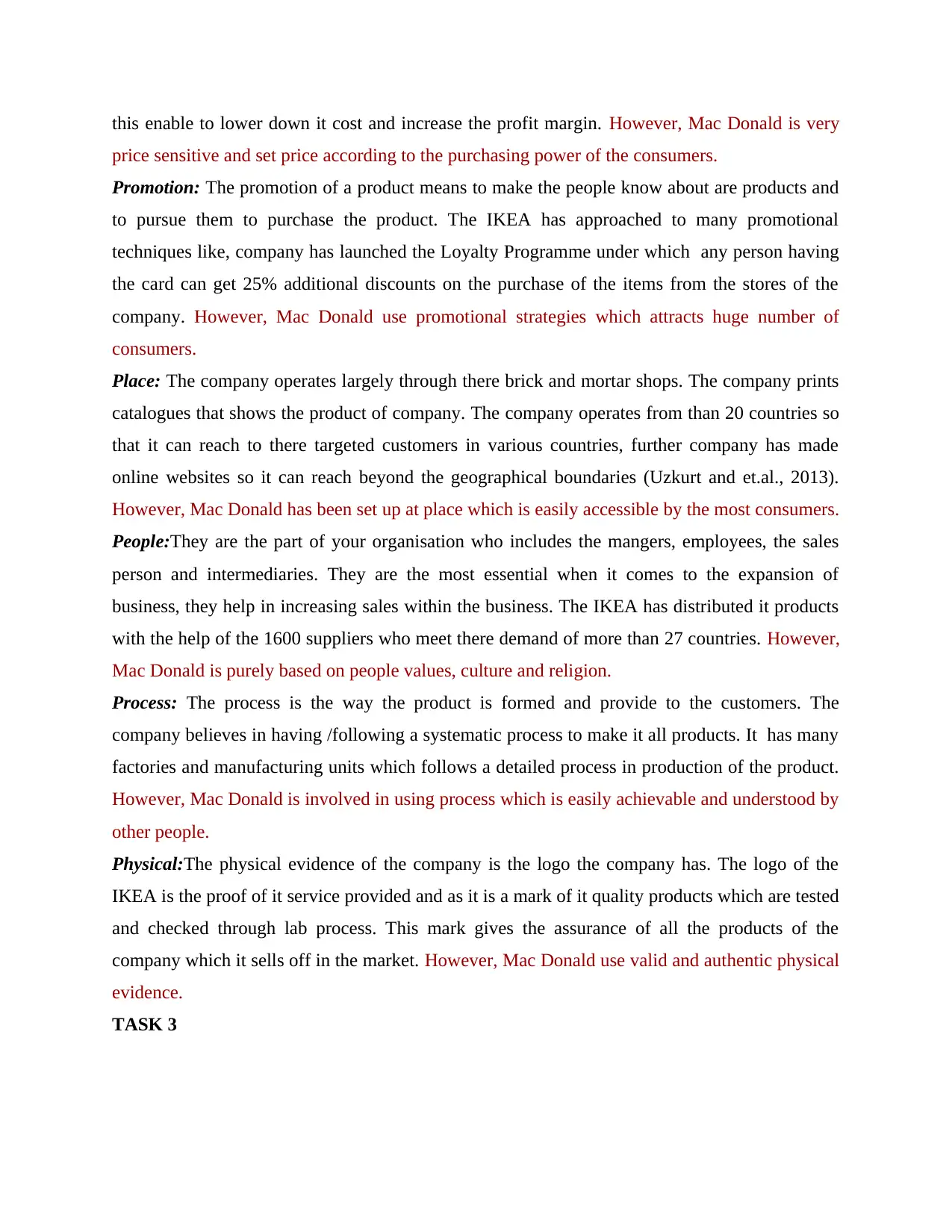
this enable to lower down it cost and increase the profit margin. However, Mac Donald is very
price sensitive and set price according to the purchasing power of the consumers.
Promotion: The promotion of a product means to make the people know about are products and
to pursue them to purchase the product. The IKEA has approached to many promotional
techniques like, company has launched the Loyalty Programme under which any person having
the card can get 25% additional discounts on the purchase of the items from the stores of the
company. However, Mac Donald use promotional strategies which attracts huge number of
consumers.
Place: The company operates largely through there brick and mortar shops. The company prints
catalogues that shows the product of company. The company operates from than 20 countries so
that it can reach to there targeted customers in various countries, further company has made
online websites so it can reach beyond the geographical boundaries (Uzkurt and et.al., 2013).
However, Mac Donald has been set up at place which is easily accessible by the most consumers.
People:They are the part of your organisation who includes the mangers, employees, the sales
person and intermediaries. They are the most essential when it comes to the expansion of
business, they help in increasing sales within the business. The IKEA has distributed it products
with the help of the 1600 suppliers who meet there demand of more than 27 countries. However,
Mac Donald is purely based on people values, culture and religion.
Process: The process is the way the product is formed and provide to the customers. The
company believes in having /following a systematic process to make it all products. It has many
factories and manufacturing units which follows a detailed process in production of the product.
However, Mac Donald is involved in using process which is easily achievable and understood by
other people.
Physical:The physical evidence of the company is the logo the company has. The logo of the
IKEA is the proof of it service provided and as it is a mark of it quality products which are tested
and checked through lab process. This mark gives the assurance of all the products of the
company which it sells off in the market. However, Mac Donald use valid and authentic physical
evidence.
TASK 3
price sensitive and set price according to the purchasing power of the consumers.
Promotion: The promotion of a product means to make the people know about are products and
to pursue them to purchase the product. The IKEA has approached to many promotional
techniques like, company has launched the Loyalty Programme under which any person having
the card can get 25% additional discounts on the purchase of the items from the stores of the
company. However, Mac Donald use promotional strategies which attracts huge number of
consumers.
Place: The company operates largely through there brick and mortar shops. The company prints
catalogues that shows the product of company. The company operates from than 20 countries so
that it can reach to there targeted customers in various countries, further company has made
online websites so it can reach beyond the geographical boundaries (Uzkurt and et.al., 2013).
However, Mac Donald has been set up at place which is easily accessible by the most consumers.
People:They are the part of your organisation who includes the mangers, employees, the sales
person and intermediaries. They are the most essential when it comes to the expansion of
business, they help in increasing sales within the business. The IKEA has distributed it products
with the help of the 1600 suppliers who meet there demand of more than 27 countries. However,
Mac Donald is purely based on people values, culture and religion.
Process: The process is the way the product is formed and provide to the customers. The
company believes in having /following a systematic process to make it all products. It has many
factories and manufacturing units which follows a detailed process in production of the product.
However, Mac Donald is involved in using process which is easily achievable and understood by
other people.
Physical:The physical evidence of the company is the logo the company has. The logo of the
IKEA is the proof of it service provided and as it is a mark of it quality products which are tested
and checked through lab process. This mark gives the assurance of all the products of the
company which it sells off in the market. However, Mac Donald use valid and authentic physical
evidence.
TASK 3
Paraphrase This Document
Need a fresh take? Get an instant paraphrase of this document with our AI Paraphraser
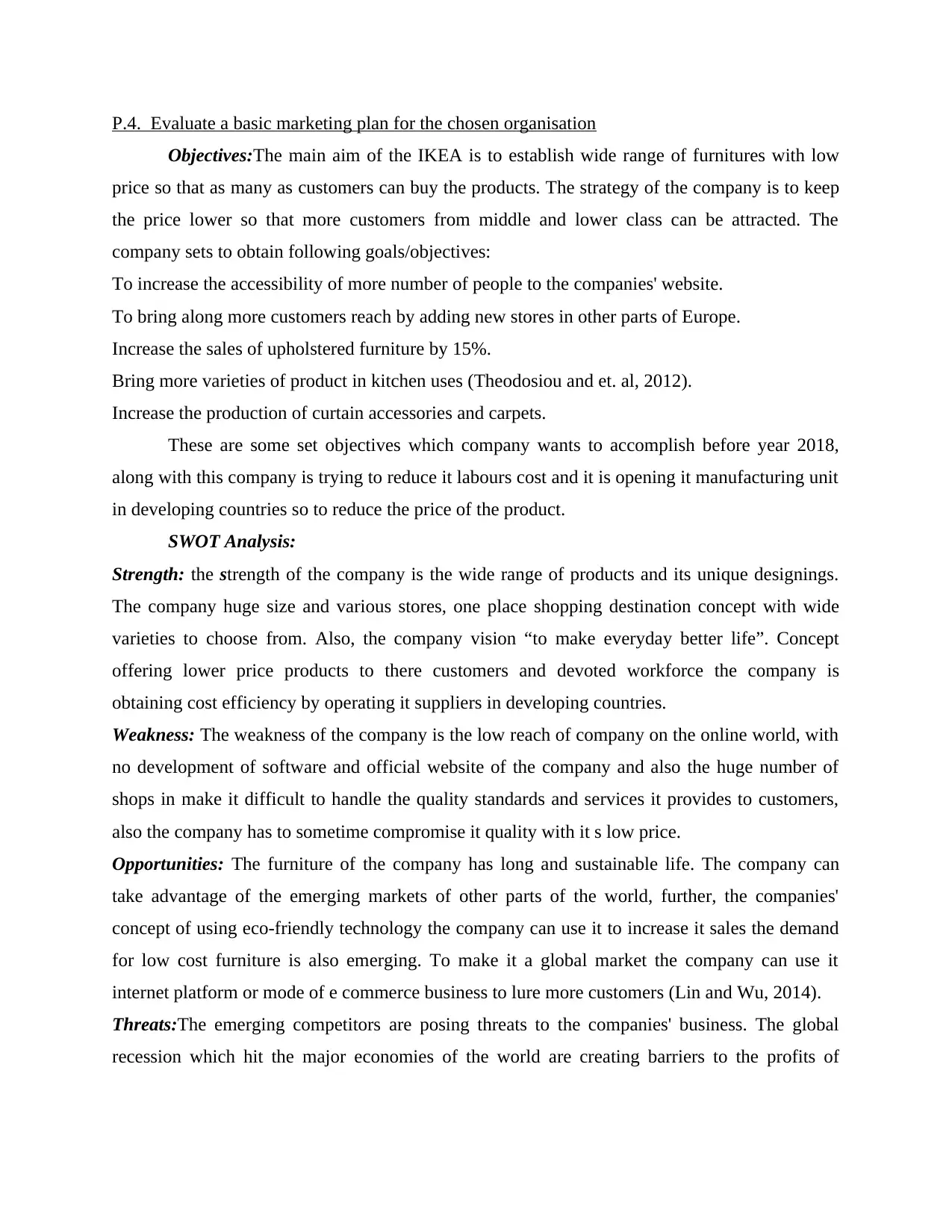
P.4. Evaluate a basic marketing plan for the chosen organisation
Objectives:The main aim of the IKEA is to establish wide range of furnitures with low
price so that as many as customers can buy the products. The strategy of the company is to keep
the price lower so that more customers from middle and lower class can be attracted. The
company sets to obtain following goals/objectives:
To increase the accessibility of more number of people to the companies' website.
To bring along more customers reach by adding new stores in other parts of Europe.
Increase the sales of upholstered furniture by 15%.
Bring more varieties of product in kitchen uses (Theodosiou and et. al, 2012).
Increase the production of curtain accessories and carpets.
These are some set objectives which company wants to accomplish before year 2018,
along with this company is trying to reduce it labours cost and it is opening it manufacturing unit
in developing countries so to reduce the price of the product.
SWOT Analysis:
Strength: the strength of the company is the wide range of products and its unique designings.
The company huge size and various stores, one place shopping destination concept with wide
varieties to choose from. Also, the company vision “to make everyday better life”. Concept
offering lower price products to there customers and devoted workforce the company is
obtaining cost efficiency by operating it suppliers in developing countries.
Weakness: The weakness of the company is the low reach of company on the online world, with
no development of software and official website of the company and also the huge number of
shops in make it difficult to handle the quality standards and services it provides to customers,
also the company has to sometime compromise it quality with it s low price.
Opportunities: The furniture of the company has long and sustainable life. The company can
take advantage of the emerging markets of other parts of the world, further, the companies'
concept of using eco-friendly technology the company can use it to increase it sales the demand
for low cost furniture is also emerging. To make it a global market the company can use it
internet platform or mode of e commerce business to lure more customers (Lin and Wu, 2014).
Threats:The emerging competitors are posing threats to the companies' business. The global
recession which hit the major economies of the world are creating barriers to the profits of
Objectives:The main aim of the IKEA is to establish wide range of furnitures with low
price so that as many as customers can buy the products. The strategy of the company is to keep
the price lower so that more customers from middle and lower class can be attracted. The
company sets to obtain following goals/objectives:
To increase the accessibility of more number of people to the companies' website.
To bring along more customers reach by adding new stores in other parts of Europe.
Increase the sales of upholstered furniture by 15%.
Bring more varieties of product in kitchen uses (Theodosiou and et. al, 2012).
Increase the production of curtain accessories and carpets.
These are some set objectives which company wants to accomplish before year 2018,
along with this company is trying to reduce it labours cost and it is opening it manufacturing unit
in developing countries so to reduce the price of the product.
SWOT Analysis:
Strength: the strength of the company is the wide range of products and its unique designings.
The company huge size and various stores, one place shopping destination concept with wide
varieties to choose from. Also, the company vision “to make everyday better life”. Concept
offering lower price products to there customers and devoted workforce the company is
obtaining cost efficiency by operating it suppliers in developing countries.
Weakness: The weakness of the company is the low reach of company on the online world, with
no development of software and official website of the company and also the huge number of
shops in make it difficult to handle the quality standards and services it provides to customers,
also the company has to sometime compromise it quality with it s low price.
Opportunities: The furniture of the company has long and sustainable life. The company can
take advantage of the emerging markets of other parts of the world, further, the companies'
concept of using eco-friendly technology the company can use it to increase it sales the demand
for low cost furniture is also emerging. To make it a global market the company can use it
internet platform or mode of e commerce business to lure more customers (Lin and Wu, 2014).
Threats:The emerging competitors are posing threats to the companies' business. The global
recession which hit the major economies of the world are creating barriers to the profits of
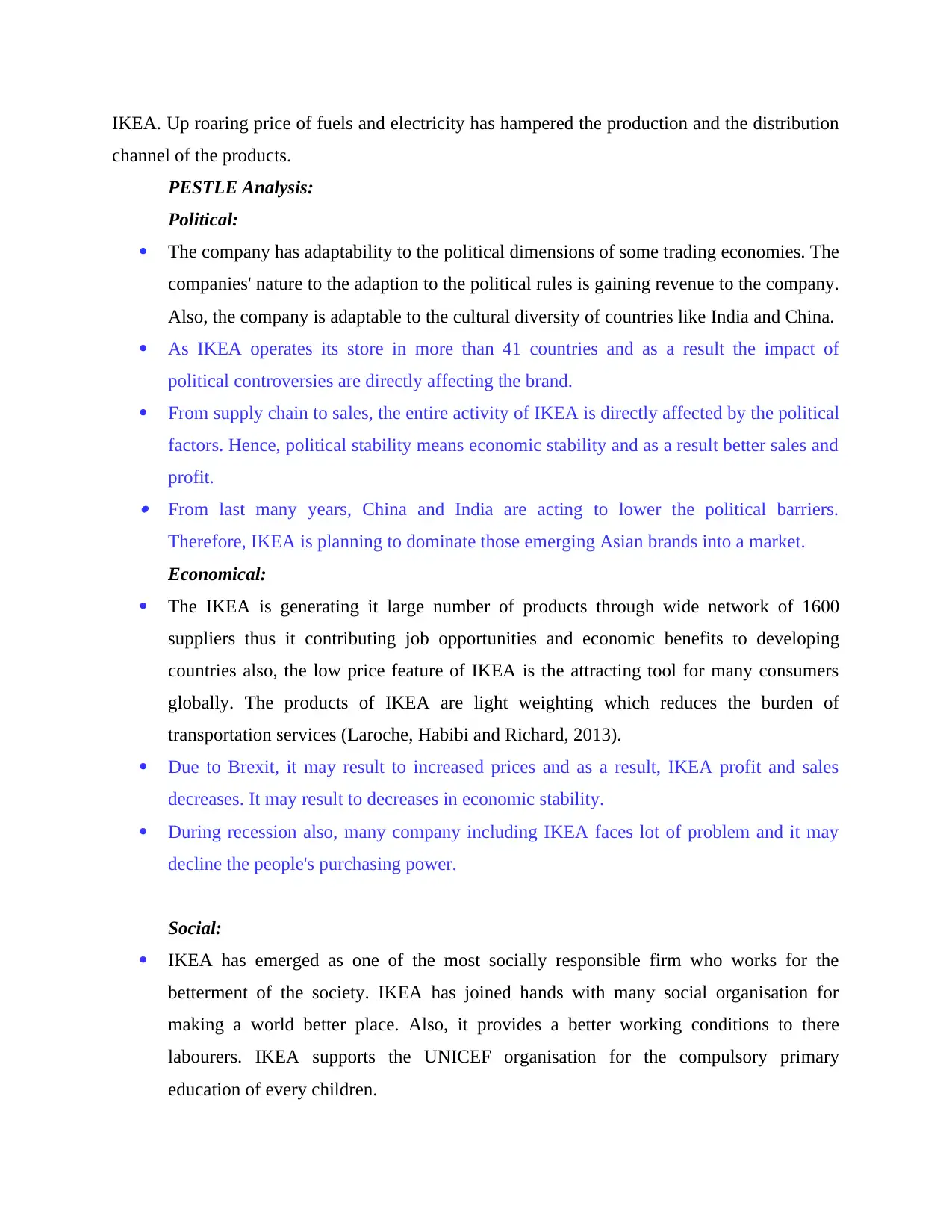
IKEA. Up roaring price of fuels and electricity has hampered the production and the distribution
channel of the products.
PESTLE Analysis:
Political:
The company has adaptability to the political dimensions of some trading economies. The
companies' nature to the adaption to the political rules is gaining revenue to the company.
Also, the company is adaptable to the cultural diversity of countries like India and China.
As IKEA operates its store in more than 41 countries and as a result the impact of
political controversies are directly affecting the brand.
From supply chain to sales, the entire activity of IKEA is directly affected by the political
factors. Hence, political stability means economic stability and as a result better sales and
profit. From last many years, China and India are acting to lower the political barriers.
Therefore, IKEA is planning to dominate those emerging Asian brands into a market.
Economical:
The IKEA is generating it large number of products through wide network of 1600
suppliers thus it contributing job opportunities and economic benefits to developing
countries also, the low price feature of IKEA is the attracting tool for many consumers
globally. The products of IKEA are light weighting which reduces the burden of
transportation services (Laroche, Habibi and Richard, 2013).
Due to Brexit, it may result to increased prices and as a result, IKEA profit and sales
decreases. It may result to decreases in economic stability.
During recession also, many company including IKEA faces lot of problem and it may
decline the people's purchasing power.
Social:
IKEA has emerged as one of the most socially responsible firm who works for the
betterment of the society. IKEA has joined hands with many social organisation for
making a world better place. Also, it provides a better working conditions to there
labourers. IKEA supports the UNICEF organisation for the compulsory primary
education of every children.
channel of the products.
PESTLE Analysis:
Political:
The company has adaptability to the political dimensions of some trading economies. The
companies' nature to the adaption to the political rules is gaining revenue to the company.
Also, the company is adaptable to the cultural diversity of countries like India and China.
As IKEA operates its store in more than 41 countries and as a result the impact of
political controversies are directly affecting the brand.
From supply chain to sales, the entire activity of IKEA is directly affected by the political
factors. Hence, political stability means economic stability and as a result better sales and
profit. From last many years, China and India are acting to lower the political barriers.
Therefore, IKEA is planning to dominate those emerging Asian brands into a market.
Economical:
The IKEA is generating it large number of products through wide network of 1600
suppliers thus it contributing job opportunities and economic benefits to developing
countries also, the low price feature of IKEA is the attracting tool for many consumers
globally. The products of IKEA are light weighting which reduces the burden of
transportation services (Laroche, Habibi and Richard, 2013).
Due to Brexit, it may result to increased prices and as a result, IKEA profit and sales
decreases. It may result to decreases in economic stability.
During recession also, many company including IKEA faces lot of problem and it may
decline the people's purchasing power.
Social:
IKEA has emerged as one of the most socially responsible firm who works for the
betterment of the society. IKEA has joined hands with many social organisation for
making a world better place. Also, it provides a better working conditions to there
labourers. IKEA supports the UNICEF organisation for the compulsory primary
education of every children.
⊘ This is a preview!⊘
Do you want full access?
Subscribe today to unlock all pages.

Trusted by 1+ million students worldwide
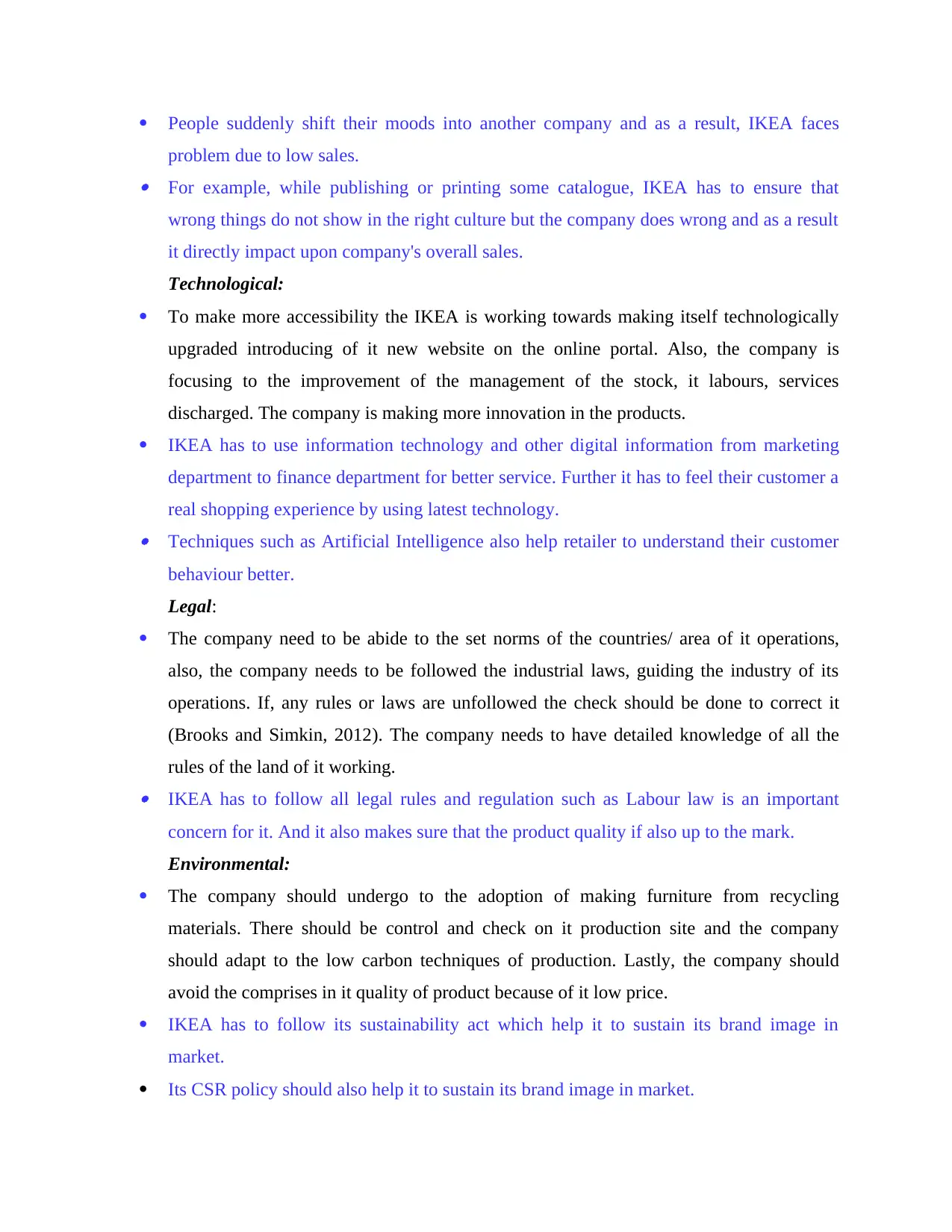
People suddenly shift their moods into another company and as a result, IKEA faces
problem due to low sales. For example, while publishing or printing some catalogue, IKEA has to ensure that
wrong things do not show in the right culture but the company does wrong and as a result
it directly impact upon company's overall sales.
Technological:
To make more accessibility the IKEA is working towards making itself technologically
upgraded introducing of it new website on the online portal. Also, the company is
focusing to the improvement of the management of the stock, it labours, services
discharged. The company is making more innovation in the products.
IKEA has to use information technology and other digital information from marketing
department to finance department for better service. Further it has to feel their customer a
real shopping experience by using latest technology. Techniques such as Artificial Intelligence also help retailer to understand their customer
behaviour better.
Legal:
The company need to be abide to the set norms of the countries/ area of it operations,
also, the company needs to be followed the industrial laws, guiding the industry of its
operations. If, any rules or laws are unfollowed the check should be done to correct it
(Brooks and Simkin, 2012). The company needs to have detailed knowledge of all the
rules of the land of it working. IKEA has to follow all legal rules and regulation such as Labour law is an important
concern for it. And it also makes sure that the product quality if also up to the mark.
Environmental:
The company should undergo to the adoption of making furniture from recycling
materials. There should be control and check on it production site and the company
should adapt to the low carbon techniques of production. Lastly, the company should
avoid the comprises in it quality of product because of it low price.
IKEA has to follow its sustainability act which help it to sustain its brand image in
market.
Its CSR policy should also help it to sustain its brand image in market.
problem due to low sales. For example, while publishing or printing some catalogue, IKEA has to ensure that
wrong things do not show in the right culture but the company does wrong and as a result
it directly impact upon company's overall sales.
Technological:
To make more accessibility the IKEA is working towards making itself technologically
upgraded introducing of it new website on the online portal. Also, the company is
focusing to the improvement of the management of the stock, it labours, services
discharged. The company is making more innovation in the products.
IKEA has to use information technology and other digital information from marketing
department to finance department for better service. Further it has to feel their customer a
real shopping experience by using latest technology. Techniques such as Artificial Intelligence also help retailer to understand their customer
behaviour better.
Legal:
The company need to be abide to the set norms of the countries/ area of it operations,
also, the company needs to be followed the industrial laws, guiding the industry of its
operations. If, any rules or laws are unfollowed the check should be done to correct it
(Brooks and Simkin, 2012). The company needs to have detailed knowledge of all the
rules of the land of it working. IKEA has to follow all legal rules and regulation such as Labour law is an important
concern for it. And it also makes sure that the product quality if also up to the mark.
Environmental:
The company should undergo to the adoption of making furniture from recycling
materials. There should be control and check on it production site and the company
should adapt to the low carbon techniques of production. Lastly, the company should
avoid the comprises in it quality of product because of it low price.
IKEA has to follow its sustainability act which help it to sustain its brand image in
market.
Its CSR policy should also help it to sustain its brand image in market.
Paraphrase This Document
Need a fresh take? Get an instant paraphrase of this document with our AI Paraphraser

Marketing plan.
The marketing plan which IKEA has set up in order to attract consumer are includes
identifying ways due to which consumer will be attracted to the company. They would be
involved in analysing the targets that has been set up by the organisation. Ikea may be engage in
identifying the competitors with whom they can have threat and may result in deteriorating their
growth. They would keep their focus on the target consumers in order to gain competitive
advantage. Marketing goals would be set according to it, only and all the strategies would be
made by company on basis of it only.
Budget plan
The budget is solely set up by the company on basis of goals set up by the company. It
compels members of the organization to use funds efficiently. It provides accurate information to
analyse, adjust and evaluate programs and activities. It also supports company in making
decisions. For setting budget general policies related to it would also be made by organisation.
This strategy also help in making the companies earn more profit.
The marketing plan which IKEA has set up in order to attract consumer are includes
identifying ways due to which consumer will be attracted to the company. They would be
involved in analysing the targets that has been set up by the organisation. Ikea may be engage in
identifying the competitors with whom they can have threat and may result in deteriorating their
growth. They would keep their focus on the target consumers in order to gain competitive
advantage. Marketing goals would be set according to it, only and all the strategies would be
made by company on basis of it only.
Budget plan
The budget is solely set up by the company on basis of goals set up by the company. It
compels members of the organization to use funds efficiently. It provides accurate information to
analyse, adjust and evaluate programs and activities. It also supports company in making
decisions. For setting budget general policies related to it would also be made by organisation.
This strategy also help in making the companies earn more profit.
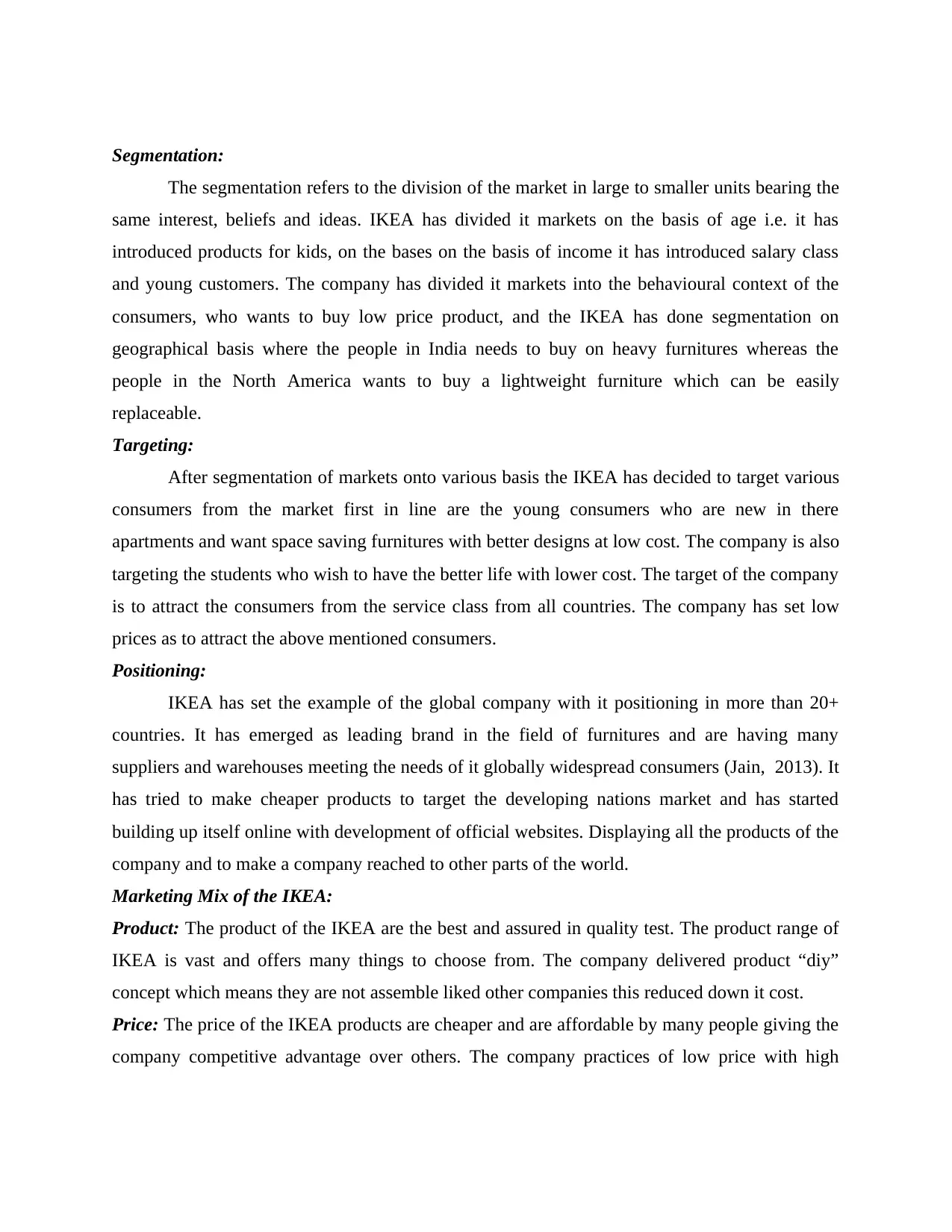
Segmentation:
The segmentation refers to the division of the market in large to smaller units bearing the
same interest, beliefs and ideas. IKEA has divided it markets on the basis of age i.e. it has
introduced products for kids, on the bases on the basis of income it has introduced salary class
and young customers. The company has divided it markets into the behavioural context of the
consumers, who wants to buy low price product, and the IKEA has done segmentation on
geographical basis where the people in India needs to buy on heavy furnitures whereas the
people in the North America wants to buy a lightweight furniture which can be easily
replaceable.
Targeting:
After segmentation of markets onto various basis the IKEA has decided to target various
consumers from the market first in line are the young consumers who are new in there
apartments and want space saving furnitures with better designs at low cost. The company is also
targeting the students who wish to have the better life with lower cost. The target of the company
is to attract the consumers from the service class from all countries. The company has set low
prices as to attract the above mentioned consumers.
Positioning:
IKEA has set the example of the global company with it positioning in more than 20+
countries. It has emerged as leading brand in the field of furnitures and are having many
suppliers and warehouses meeting the needs of it globally widespread consumers (Jain, 2013). It
has tried to make cheaper products to target the developing nations market and has started
building up itself online with development of official websites. Displaying all the products of the
company and to make a company reached to other parts of the world.
Marketing Mix of the IKEA:
Product: The product of the IKEA are the best and assured in quality test. The product range of
IKEA is vast and offers many things to choose from. The company delivered product “diy”
concept which means they are not assemble liked other companies this reduced down it cost.
Price: The price of the IKEA products are cheaper and are affordable by many people giving the
company competitive advantage over others. The company practices of low price with high
The segmentation refers to the division of the market in large to smaller units bearing the
same interest, beliefs and ideas. IKEA has divided it markets on the basis of age i.e. it has
introduced products for kids, on the bases on the basis of income it has introduced salary class
and young customers. The company has divided it markets into the behavioural context of the
consumers, who wants to buy low price product, and the IKEA has done segmentation on
geographical basis where the people in India needs to buy on heavy furnitures whereas the
people in the North America wants to buy a lightweight furniture which can be easily
replaceable.
Targeting:
After segmentation of markets onto various basis the IKEA has decided to target various
consumers from the market first in line are the young consumers who are new in there
apartments and want space saving furnitures with better designs at low cost. The company is also
targeting the students who wish to have the better life with lower cost. The target of the company
is to attract the consumers from the service class from all countries. The company has set low
prices as to attract the above mentioned consumers.
Positioning:
IKEA has set the example of the global company with it positioning in more than 20+
countries. It has emerged as leading brand in the field of furnitures and are having many
suppliers and warehouses meeting the needs of it globally widespread consumers (Jain, 2013). It
has tried to make cheaper products to target the developing nations market and has started
building up itself online with development of official websites. Displaying all the products of the
company and to make a company reached to other parts of the world.
Marketing Mix of the IKEA:
Product: The product of the IKEA are the best and assured in quality test. The product range of
IKEA is vast and offers many things to choose from. The company delivered product “diy”
concept which means they are not assemble liked other companies this reduced down it cost.
Price: The price of the IKEA products are cheaper and are affordable by many people giving the
company competitive advantage over others. The company practices of low price with high
⊘ This is a preview!⊘
Do you want full access?
Subscribe today to unlock all pages.

Trusted by 1+ million students worldwide
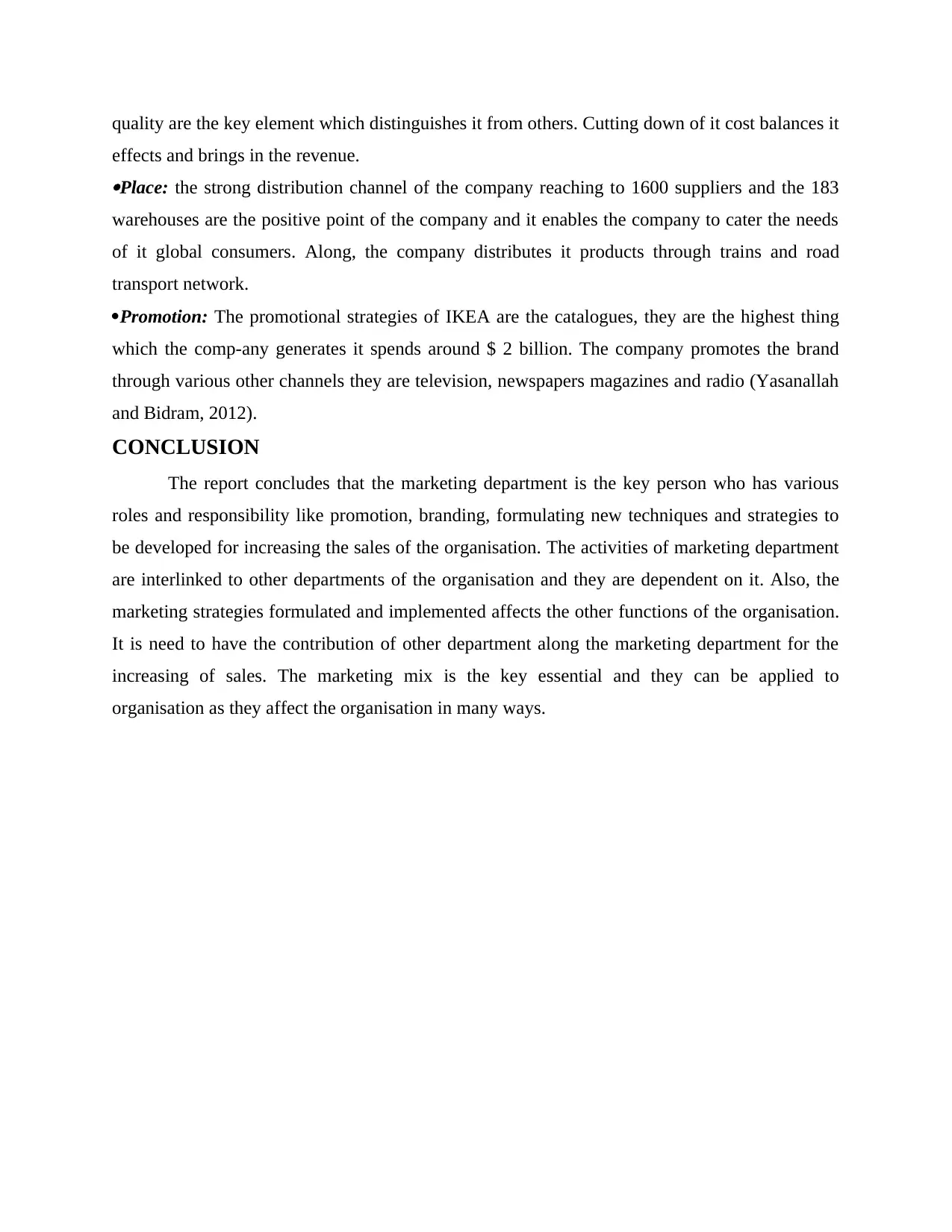
quality are the key element which distinguishes it from others. Cutting down of it cost balances it
effects and brings in the revenue.Place: the strong distribution channel of the company reaching to 1600 suppliers and the 183
warehouses are the positive point of the company and it enables the company to cater the needs
of it global consumers. Along, the company distributes it products through trains and road
transport network.
Promotion: The promotional strategies of IKEA are the catalogues, they are the highest thing
which the comp-any generates it spends around $ 2 billion. The company promotes the brand
through various other channels they are television, newspapers magazines and radio (Yasanallah
and Bidram, 2012).
CONCLUSION
The report concludes that the marketing department is the key person who has various
roles and responsibility like promotion, branding, formulating new techniques and strategies to
be developed for increasing the sales of the organisation. The activities of marketing department
are interlinked to other departments of the organisation and they are dependent on it. Also, the
marketing strategies formulated and implemented affects the other functions of the organisation.
It is need to have the contribution of other department along the marketing department for the
increasing of sales. The marketing mix is the key essential and they can be applied to
organisation as they affect the organisation in many ways.
effects and brings in the revenue.Place: the strong distribution channel of the company reaching to 1600 suppliers and the 183
warehouses are the positive point of the company and it enables the company to cater the needs
of it global consumers. Along, the company distributes it products through trains and road
transport network.
Promotion: The promotional strategies of IKEA are the catalogues, they are the highest thing
which the comp-any generates it spends around $ 2 billion. The company promotes the brand
through various other channels they are television, newspapers magazines and radio (Yasanallah
and Bidram, 2012).
CONCLUSION
The report concludes that the marketing department is the key person who has various
roles and responsibility like promotion, branding, formulating new techniques and strategies to
be developed for increasing the sales of the organisation. The activities of marketing department
are interlinked to other departments of the organisation and they are dependent on it. Also, the
marketing strategies formulated and implemented affects the other functions of the organisation.
It is need to have the contribution of other department along the marketing department for the
increasing of sales. The marketing mix is the key essential and they can be applied to
organisation as they affect the organisation in many ways.
Paraphrase This Document
Need a fresh take? Get an instant paraphrase of this document with our AI Paraphraser
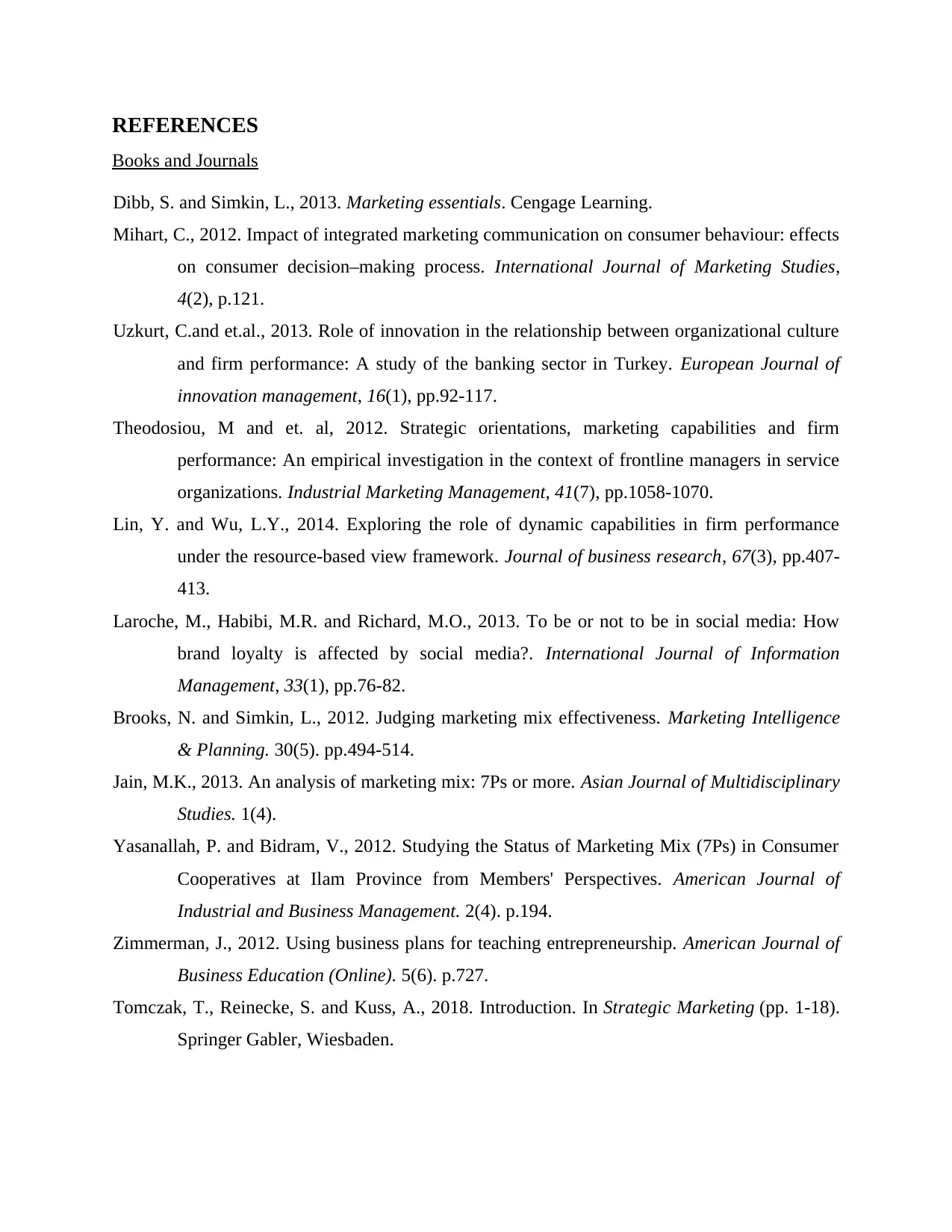
REFERENCES
Books and Journals
Dibb, S. and Simkin, L., 2013. Marketing essentials. Cengage Learning.
Mihart, C., 2012. Impact of integrated marketing communication on consumer behaviour: effects
on consumer decision–making process. International Journal of Marketing Studies,
4(2), p.121.
Uzkurt, C.and et.al., 2013. Role of innovation in the relationship between organizational culture
and firm performance: A study of the banking sector in Turkey. European Journal of
innovation management, 16(1), pp.92-117.
Theodosiou, M and et. al, 2012. Strategic orientations, marketing capabilities and firm
performance: An empirical investigation in the context of frontline managers in service
organizations. Industrial Marketing Management, 41(7), pp.1058-1070.
Lin, Y. and Wu, L.Y., 2014. Exploring the role of dynamic capabilities in firm performance
under the resource-based view framework. Journal of business research, 67(3), pp.407-
413.
Laroche, M., Habibi, M.R. and Richard, M.O., 2013. To be or not to be in social media: How
brand loyalty is affected by social media?. International Journal of Information
Management, 33(1), pp.76-82.
Brooks, N. and Simkin, L., 2012. Judging marketing mix effectiveness. Marketing Intelligence
& Planning. 30(5). pp.494-514.
Jain, M.K., 2013. An analysis of marketing mix: 7Ps or more. Asian Journal of Multidisciplinary
Studies. 1(4).
Yasanallah, P. and Bidram, V., 2012. Studying the Status of Marketing Mix (7Ps) in Consumer
Cooperatives at Ilam Province from Members' Perspectives. American Journal of
Industrial and Business Management. 2(4). p.194.
Zimmerman, J., 2012. Using business plans for teaching entrepreneurship. American Journal of
Business Education (Online). 5(6). p.727.
Tomczak, T., Reinecke, S. and Kuss, A., 2018. Introduction. In Strategic Marketing (pp. 1-18).
Springer Gabler, Wiesbaden.
Books and Journals
Dibb, S. and Simkin, L., 2013. Marketing essentials. Cengage Learning.
Mihart, C., 2012. Impact of integrated marketing communication on consumer behaviour: effects
on consumer decision–making process. International Journal of Marketing Studies,
4(2), p.121.
Uzkurt, C.and et.al., 2013. Role of innovation in the relationship between organizational culture
and firm performance: A study of the banking sector in Turkey. European Journal of
innovation management, 16(1), pp.92-117.
Theodosiou, M and et. al, 2012. Strategic orientations, marketing capabilities and firm
performance: An empirical investigation in the context of frontline managers in service
organizations. Industrial Marketing Management, 41(7), pp.1058-1070.
Lin, Y. and Wu, L.Y., 2014. Exploring the role of dynamic capabilities in firm performance
under the resource-based view framework. Journal of business research, 67(3), pp.407-
413.
Laroche, M., Habibi, M.R. and Richard, M.O., 2013. To be or not to be in social media: How
brand loyalty is affected by social media?. International Journal of Information
Management, 33(1), pp.76-82.
Brooks, N. and Simkin, L., 2012. Judging marketing mix effectiveness. Marketing Intelligence
& Planning. 30(5). pp.494-514.
Jain, M.K., 2013. An analysis of marketing mix: 7Ps or more. Asian Journal of Multidisciplinary
Studies. 1(4).
Yasanallah, P. and Bidram, V., 2012. Studying the Status of Marketing Mix (7Ps) in Consumer
Cooperatives at Ilam Province from Members' Perspectives. American Journal of
Industrial and Business Management. 2(4). p.194.
Zimmerman, J., 2012. Using business plans for teaching entrepreneurship. American Journal of
Business Education (Online). 5(6). p.727.
Tomczak, T., Reinecke, S. and Kuss, A., 2018. Introduction. In Strategic Marketing (pp. 1-18).
Springer Gabler, Wiesbaden.

Liu, Y., Li, and et.al. 2017. The Effects of Products’ Aesthetic Design on Demand and
Marketing-Mix Effectiveness: The Role of Segment Prototypicality and Brand
Consistency. Journal of Marketing. 81(1). pp.83-102.
Papadopoulos, N. and Heslop, L. A., 2014. Product-country images: Impact and role in
international marketing. Routledge.
Marketing-Mix Effectiveness: The Role of Segment Prototypicality and Brand
Consistency. Journal of Marketing. 81(1). pp.83-102.
Papadopoulos, N. and Heslop, L. A., 2014. Product-country images: Impact and role in
international marketing. Routledge.
⊘ This is a preview!⊘
Do you want full access?
Subscribe today to unlock all pages.

Trusted by 1+ million students worldwide
1 out of 15
Related Documents
Your All-in-One AI-Powered Toolkit for Academic Success.
+13062052269
info@desklib.com
Available 24*7 on WhatsApp / Email
![[object Object]](/_next/static/media/star-bottom.7253800d.svg)
Unlock your academic potential
Copyright © 2020–2025 A2Z Services. All Rights Reserved. Developed and managed by ZUCOL.





